Debating EAP Worksheets, Activities & Games
Round-Robin Mini-Debates
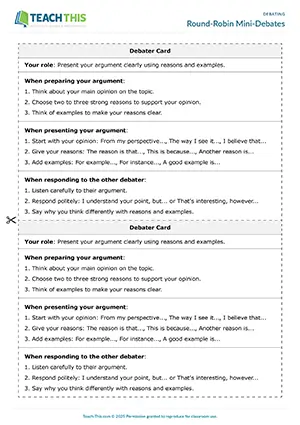
EAP Debating Activity - Speaking: Debating, Guided Discussion, Self-reflection, Communicative Practice - Group Work
In this insightful debating activity, students rotate through three short debates on the same topic, taking turns to argue 'for', argue 'against', and moderate, reusing and improving good ideas as...
Academic Debate Challenge
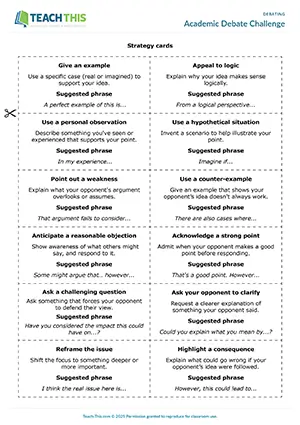
EAP Debating Game - Speaking: Debating, Communicative Practice - Group Work
In this engaging debating game, students compete to win a series of mini-debates by using strategy cards to build and respond to academic arguments. To begin, the moderator draws a topic card, reads it aloud, and assigns one student to argue 'for' and...
Debate Rebuttals

EAP Debate Rebuttals Worksheet - Reading and Writing Exercises: Writing Paragraphs - Speaking Activity: Presenting Rebuttals, Freer Practice - Group Work
In this comprehensive debate rebuttals worksheet, students practice formulating and presenting rebuttals. First, students read a brief introduction to debate...
Let's Debate
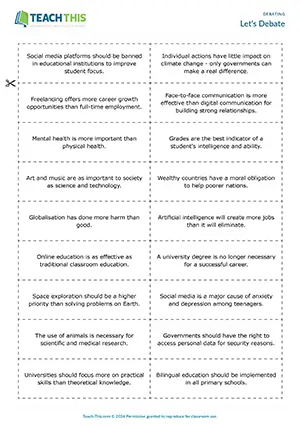
EAP Debating Activity - Vocabulary Exercises: Categorising, Gap-fill - Speaking Activity: Debating, Freer and Communicative Practice - Pair Work
In this interesting debating skills activity, students practice phrases for expressing opinions, agreeing and disagreeing and then participate in a series of mini...
Structuring an Argument
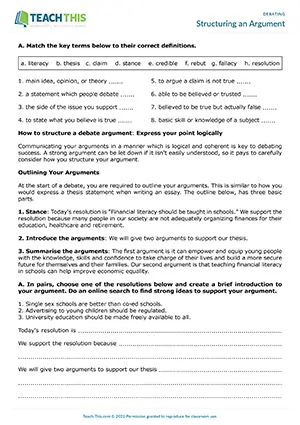
EAP Structuring Arguments Worksheet - Reading and Writing Exercises: Matching, Writing Paragraphs, Revising - Speaking Activity: Presenting an Argument - Pair Work
In this useful structuring an argument worksheet, students learn, practice and present argument outlines and explanations. First, students match key...
That may be true, but...

EAP Counter-Arguments Activity - Reading, Writing and Speaking: Matching, Writing Sentences, Delivering Counter Arguments, Freer Practice - Pair Work
In this productive counter-arguments speaking activity, students practice using partial agreement to counter arguments. First, students match statements...
Common Logical Fallacies
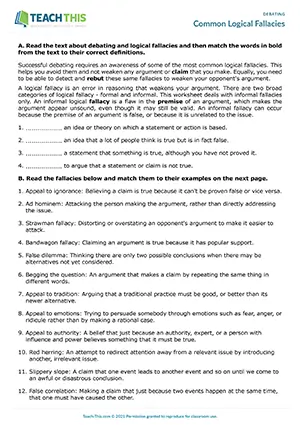
EAP Logical Fallacies Worksheet - Reading and Writing Exercises: Matching, Categorising, Writing Sentences - Speaking Activity: Identifying - Group Work
In this free logical fallacies worksheet, students become familiar with 12 common informal logical fallacies and practice identifying them. To begin...
Debate Duel
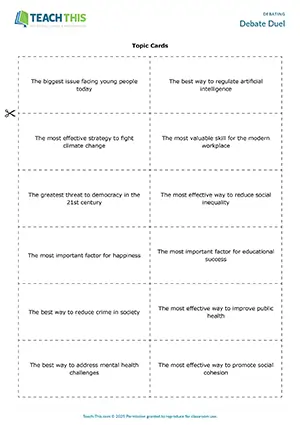
EAP Debating Game - Speaking: Debating, Communicative Practice - Group Work
In this rewarding debating game, students compete in a series of short-form debates on contemporary issues, presenting arguments and rebuttals to persuade a judge and win topic cards. In groups, each student takes on the role of Starter, Challenger, or...
Understanding Academic Debates

EAP Academic Debates Worksheet - Reading Exercises: Short Answer Questions, Multiple Choice, True, False or Not Given Questions
Here is a useful academic debates worksheet that introduces students to the way academic debates are conducted. First, students read the Affirmative team's opening statement addressing the motion...

